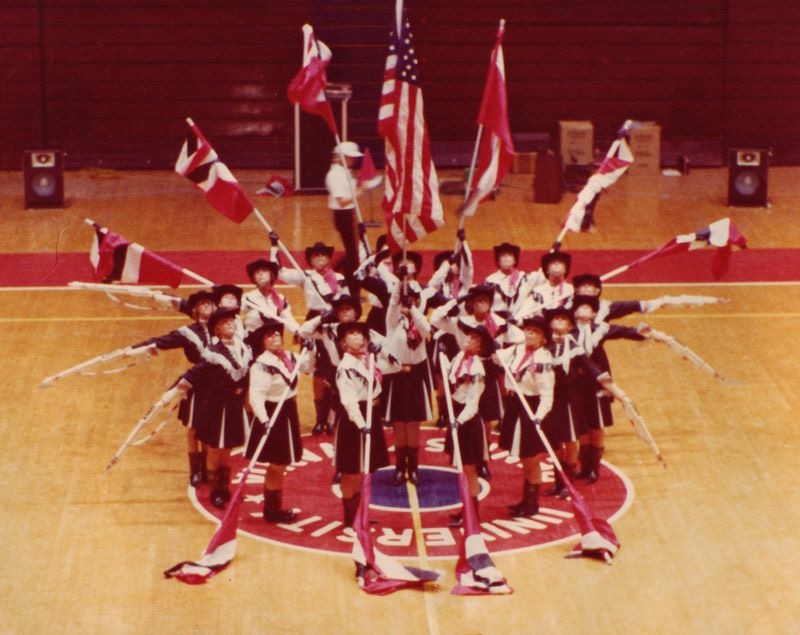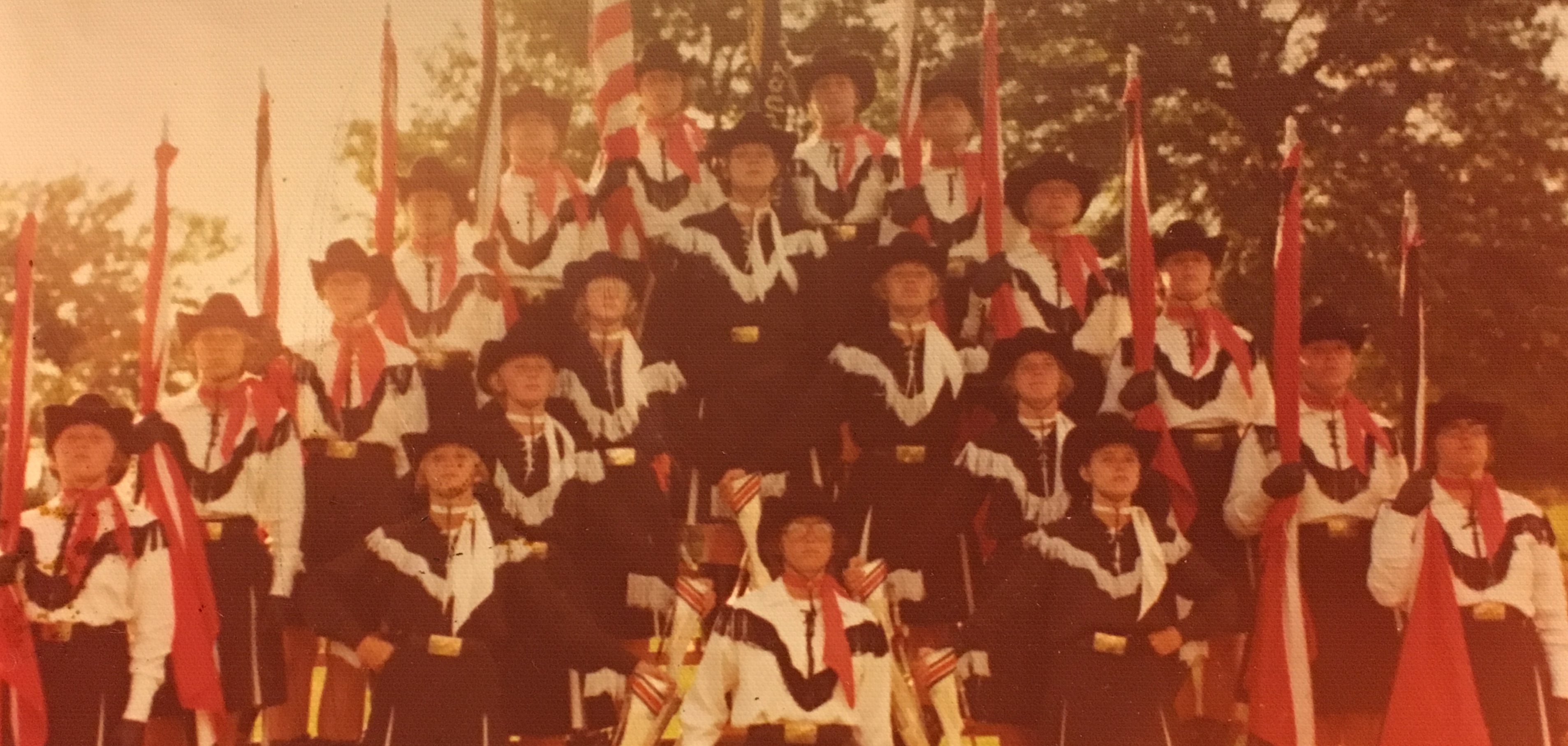Alumni Feature: 1976 Winter Guard
March 1, 2018

History was being made in drum corps 42 years ago this winter. And our corps, in particular our winter guard, was the reason for it. There were 21 girls from Dubuque, with the exception of one, that had some raw talent. In essence, they were a diamond in the rough.
In the late 1960’s, the corps color guard had made a name for itself. In the winters of 1970 and 1971, Colts Director and Hall of Famer Jim Killoran made efforts to start a winter guard. It was not until the fall of 1975, when Colts Hall of Famers Merle Mathis and Al Beckius sought to provide the opportunity for the color guard to be active in the winter months. With the able assistance of Tom Faulkner, they set out to find some able body person(s) to take on the role of developing a winter guard for the corps.
The first candidate declined. His view was that these “farm girls” from Iowa did not have the skillset or ambition to make the effort worthwhile. However, that candidate did provide names of instructors who might be interested. The corps was directed to reach out to Steve Suslick and Wally Meissner. Both had marched and worked with the Cavaliers Color Guard.
When Steve and Wally arrived at the first rehearsal, they were met by 21 naïve, happy go lucky young ladies. On rifle, there was Jody Bowman, Judy Delaney Cooper, Carol “Jelly” Jellison Sessions, Mary Sue “Eddie” Lange Crabtree, Patti “Tink” Mathis McClain, Dawn “Durf’ Murphy Carney, Joan McCann Vasquez. On flag, there was Ann Fangman Vrotsos, Chris “C.B.” Faulkner, Ellen “Alvin” Golinvaux, the late Lisa “Levi” Ingram, Vicki “Krooz” Kruser, Mary “Bubbles” Mathis, Robin “Space Cadet” Phillips, Janis “Cover Girl” Sanner, Lora “Crusher Schueller; and Cynthia “Shitmeg” Steichen. The American Flag Section of Teresa “Tess” Milligan, Deanne Mitchell Gibboney, and Donna “Teta” Engler Pluym. Their commanding officer was Jolene “Trigger” Miller O’Toole. These young ladies, a majority who were only 15 and 16 years old, were met by two color guard visionaries with the technical skills and experience to match. The consensus after the first rehearsal was that Suslick was a “jerk.” It was not apparent to these young ladies, the first competitive winter guard in Colts history, that Suslick and Meissner saw something in them that they themselves did not envision.
Steve and Wally demanded the best. They expected no less. When Steve and Wally were away, the onus of perfecting the show fell on the shoulders of corps color guard alumnus, Jane MacFarlane Kohl, Betty Wahlburn Cromartie, and Ellen Fangman McNichols. During the week, these three stalwarts continued the vision that Steve and Wally implemented.
In January of 1976, the girls had several hurdles to overcome heading into the competitive season. They were young. They were inexperienced. They were the only guard that had to travel long distances to compete. Most shows were in the Milwaukee and Chicagoland area. In essence, the guard ventured into the lion’s den every weekend to compete against the powerhouses of the day: Kilts, Silhouettes, Guardsmen, Buccaneers, and Babcock Debs, to name a few. When most of the guards slept at their homes on Saturday night between competitions, the girls slept in hotels or a gym floor. Car-pooling was the norm, in which some of the guard members were designated driving duties. Trips to these areas back in the 1970’s were not like it is today. For the first time, winter guard shows were set to music. On top of that, the Colts Winter Guard was the new kid on the block. What was really expected of them their first season out?
At the first show of the season, the Colts surprised quite a few folks. They came in third in Greenfield, Wisconsin. Mary “Bubbles” Mathis took first in in individual flag competition and Joan McCann Vasquez took sixth in individual rifle. The next day, the guard inched up to second place in Chicago, just 0.4 of a point behind the Kilts. Jolene “Trigger” Miller O’Toole was awarded Top Commanding Officer.
The girls began to sense some animosity by the other guards. How can these upstart “farm girls” from Iowa get this credit for their first season out? A story has it that at one competition, Jody Bowman could not find one of her boots. There was a discussion amongst the guard that whomever was pulling the prank needed to return Jody’s boot. No boot was returned, and Jody went on to compete with a sock instead. After the competition, the boot reappeared with a message on the bottom of the boot saying something to the effect of, “Cow shits go home!” The guard sported a western theme uniform and two Kilts guard members, in an attempt to get under Jolene’s skin, began calling her “Trigger.” However, the nickname stuck and became a badge of honor for Jolene. Ironically, those two Kilts members eventually instructed the Colts color guard in the late 1970’s into the 1980’s, Kirt Kinyon and Dave Nelson.

Instead of folding, these girls from Iowa fed off the jealousy, pushing themselves to prove that they were as good as the scores and placements dictated. Steve, Wally, and the rest of the staff gave them the product and know-how to be a top winter guard. A few weeks later, the guard won prelims in Racine, Wisconsin, topping a field of 20 other guards. Yet, at finals, they were beaten by the Silhouettes, whom had jumped up five spots and over eight points to win at finals. The guard was full of mixed emotions. Was politics in play? Did the other guard have a bad prelim show and just took it to everyone at finals? Feeling bummed, the guard headed to the next competition in Carpentersville, Illinois, via carpool. But things did not go smoothly. While the rest of the guard made it to the hotel, the Commanding Officer and Crusher were nowhere to be found. Their car went on a detour to Indiana. The two eventually made it to the hotel in the wee hours of the morning.
So how did these young girls react? Well, they won their next three competitions against the established powerhouses. Though the animosity remained, it began to wane as the other guards began to realize the Colts were a force to be reckoned with. In fact, the winter guard fans gave the girls from Dubuque “rock star” receptions at shows, to the degree that announcers at the shows were virtually drowned out by the reaction of the crowd when the Colts were announced. But would complacency set in? Come mid-March, in Kenosha, Wisconsin, the guard came in sixth place. Suslick rewarded the girls with an extended rehearsal that evening in the gym. You could hear a pin drop. The next day in Waukesha, the guard came in first. We have all heard the mantra “to be the best, you have to beat the best.” The rest of March saw the guard coming in short, placing second in the next three competitions.
The Midwest Color Guard Circuit Championships (the precursor of WGI) was on the horizon. The Colts were definitely the dark horse in the competition. Would they accomplish what the staff suspected they could attain? Would they achieve what they never thought was possible at the beginning of the season? Would they get the respect and placement they worked for and deserved?
Sitting first after prelims, a concern was in the back of their minds that what happened in Racine earlier in the year could happen again: that they could be usurped and not take home the gold. Adding to the tension was a dilemma. You see, throughout the season there were seven rifles, but only six positions in the drill. At each competition, one of the six would sit out a show. And one person, Judy Delaney Cooper, had to learn the drill and the counts for the rifle work for each of the six positions and would fill in for each of the other rifles when it was their turn to sit out a competition. But who was going to sit out for the Championship?
That decision was placed on the rifle line. They had to choose amongst themselves who would sit out of the most important show of the season. The gold medal was on the line. Mary Sue “Eddie” Lange Crabtree unselfishly took the hit. To make up for it, Deanne Mitchell Gibboney offered up her position in the American Flag Section at retreat to allow Mary Sue to be on the floor when the final scores were announced.
Ten of the 29 guards from prelims advanced to finals. There were six placement changes from prelims to finals. “In fourth Place with, 0.1 in penalties, and a final score of 86.567.... Kilts. In third place, with 0.3 in penalties, with a final score of 87.933… Silhouettes.” The tension was building. Would the wildest dreams of Suslick and Meissner bring these “farm girls” from Iowa to the top of the color guard world? Would these girls from Iowa reach a goal that they never thought fathomable just a few months earlier? “In second place, with 0.3 in penalties, with a score of 88.800...” Oh, would that penalty cause us a Championship? Would we be judged for what we did and not where we are from? “... The Guardsmen.” On April 10, 1976, the Colts Winter Color Guard was announced the 1976 Midwest Color Guard Circuit Champions with a score of 89.534. (and no penalties).
This was just a tip of the iceberg of what the guard achieved in 1976. We would like to thank the 1976 guard members and Al Beckius, who we were able to contact for this write-up. There were numerous antidotes that we just could not get into this story. We could write a book about this remarkable group of young women. Speaking with them today, one could feel the esprit de corps that exudes. What they accomplished as young women can be sensed in what they have accomplished in the rest of their lives. They are a very special group of folks. If you want to know more, make sure you make it to the alumni festivities to celebrate the corps 55th Anniversary on July 13, 2018, in Dubuque, and get your chance to speak with members of the 1976 Winter Guard.
Return to Colts News.